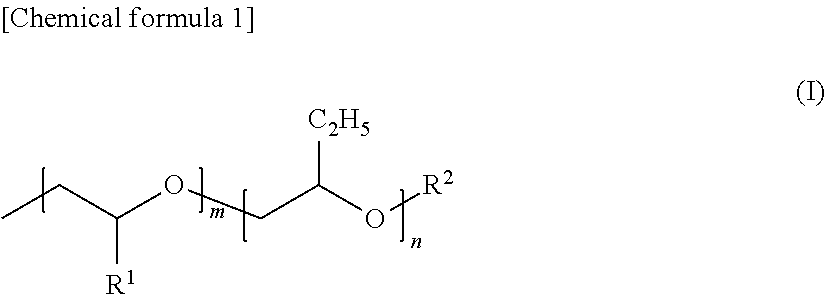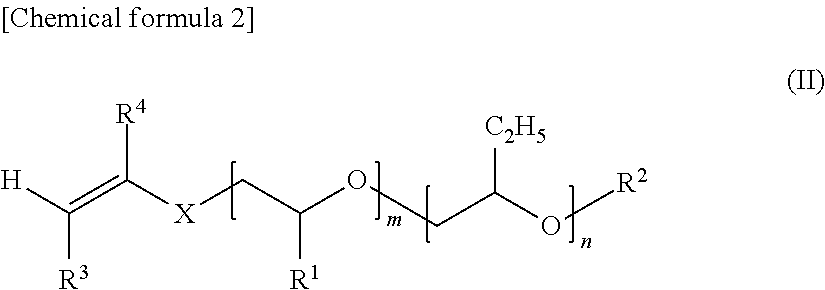Polyoxyalkylene-modified vinyl acetal polymer, and composition comprising same
a technology of polyoxyalkylene and acetal polymer, which is applied in the field of polyoxyalkylenemodified vinyl acetal polymer, can solve the problems of significant variation in composition properties, film strength, transparency and storage stability, and poor flexibility of films or sheets produced by processing vinyl butyral polymers, and achieves high mechanical strength, high plasticity, and high dispersibility.
- Summary
- Abstract
- Description
- Claims
- Application Information
AI Technical Summary
Benefits of technology
Problems solved by technology
Method used
Image
Examples
production example 1
Production of PVA1
[0108]In a 3-liter reactor equipped with a stirrer, a reflux condenser, a nitrogen inlet, a monomer dropping port and a port for adding an initiator were charged 750 g of vinyl acetate, 250 g of methanol and 3.3 g of an unsaturated monomer having POA groups (this monomer is represented by general formula (II) wherein R1 to R4, X, m and n are as shown in Table 1 and units A and B are arranged as a block), and the atmosphere of the system was replaced with nitrogen by bubbling nitrogen for 30 min. Furthermore, as a delay solution, monomer A was dissolved in methanol to prepare a solution with a concentration of 20%, whose atmosphere was replaced with nitrogen gas by nitrogen bubbling. The reactor was heated to an internal temperature of 60° C., at which 0.25 g of 2,2′-azobisisobutyronitrile (AIBN) was added to initiate polymerization. While keeping a monomer composition (a ratio of vinyl acetate to monomer A) in a polymerization solution constant by adding a delay so...
example 1
Synthesis of a POA-Modified Vinyl Acetal Polymer
[0110]As shown in Tables 1 and 2, PVA1 was prepared as a POA-modified PVA with a polymerization degree of 1700, a saponification degree of 98.9 mol %, a POA-group modification rate of 0.4 mol % (in general formula (III), R1=H, R2=H, R4=CH3, R5=H, m=2, n=13). In an internal 5-liter glass vessel equipped with a reflux condenser, a thermometer and an anchor-type stirring blade were charged 193 g of POA-modified PVA and 2900 g of water, and the mixture was stirred at 90° C. or higher for about 2 hours for complete dissolving. The POA-modified PVA solution was cooled to 38° C. with stirring. Then, to the solution were added 201 g of 35% concentration hydrochloric acid and 112 g of n-butylaldehyde, and the solution was cooled to 20° C. or less, to initiate acetalization of PVA. The temperature was kept for 15 min to precipitate POA-modified vinyl butyral polymer. Then, the solution was heated to 30° C., kept at 30° C. for 5 hours, and then c...
examples 2 to 23
[0111]POA-modified vinyl butyral polymers were produced and evaluated as described in Example 1, except that PVA1 was replaced with POA-modified PVAs shown in Tables 1 and 2 and the acetalization conditions were changed. The results are shown in Tables 2 and 3. In these examples, the vinyl butyral polymer and the plasticizer used for preparing a test piece for haze determination were satisfactorily dissolved in a mixed solvent. Furthermore, laminated ceramic capacitors could be smoothly produced by using the above ceramic green sheets. The laminated ceramic capacitors produced satisfactorily operated.
PUM
| Property | Measurement | Unit |
|---|---|---|
| temperature | aaaaa | aaaaa |
| temperature | aaaaa | aaaaa |
| temperature | aaaaa | aaaaa |
Abstract
Description
Claims
Application Information
 Login to View More
Login to View More - R&D
- Intellectual Property
- Life Sciences
- Materials
- Tech Scout
- Unparalleled Data Quality
- Higher Quality Content
- 60% Fewer Hallucinations
Browse by: Latest US Patents, China's latest patents, Technical Efficacy Thesaurus, Application Domain, Technology Topic, Popular Technical Reports.
© 2025 PatSnap. All rights reserved.Legal|Privacy policy|Modern Slavery Act Transparency Statement|Sitemap|About US| Contact US: help@patsnap.com



